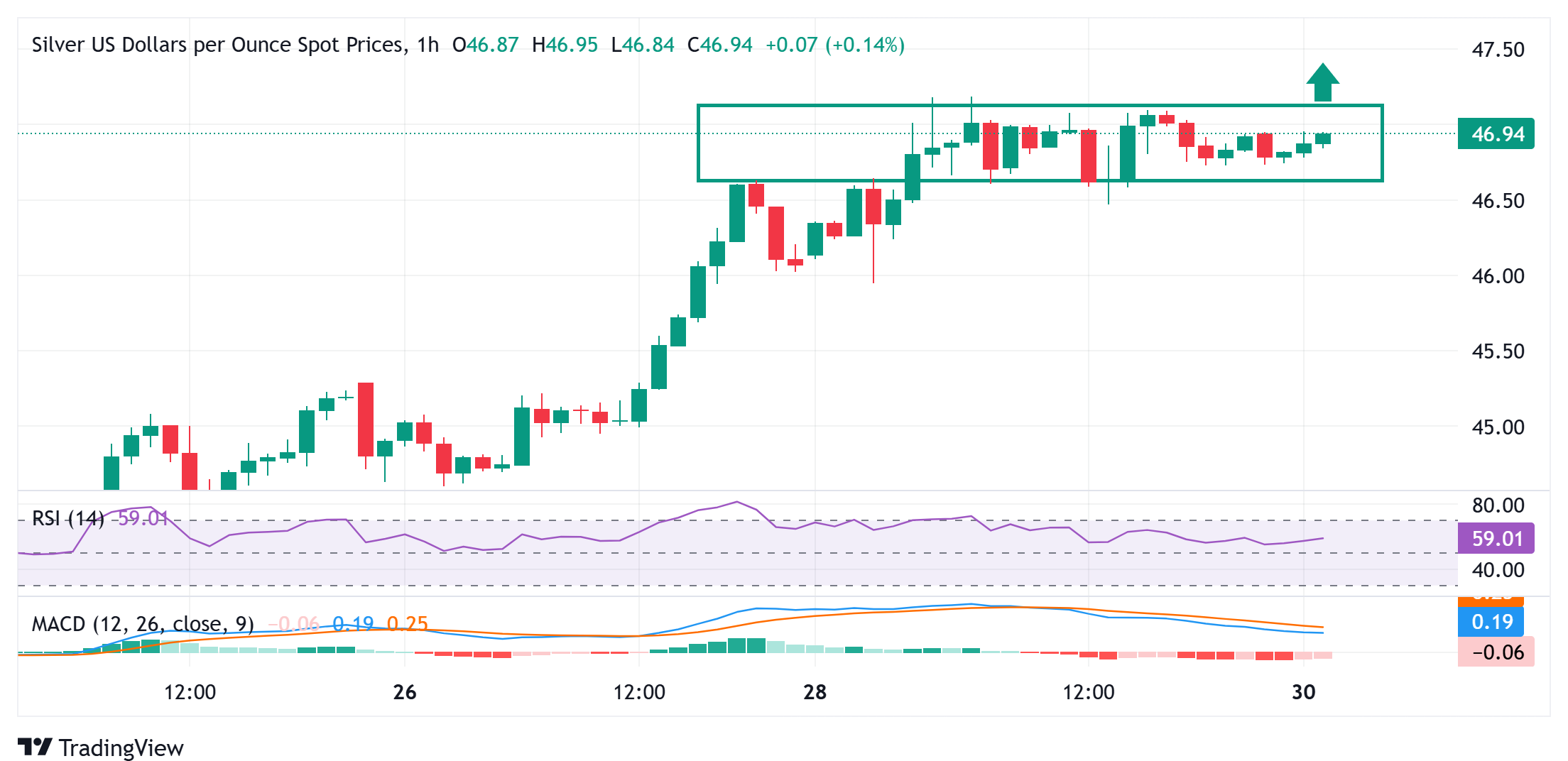Silver Price Forecast: XAG/USD trades below $47.00, near its highest level since May 2011
- Silver extends its consolidative price move amid extremely overbought conditions.
- The range-bound price action could be seen as a brief pause before the next leg up.
- Weakness below the $46.60-$46.55 support might be seen as a buying opportunity.
Silver (XAG/USD) remains confined in a range near its highest level since May 2011, touched the previous day, and trades just below the $47.00 mark during the Asian session on Tuesday.
Against the backdrop of the recent blowout rally witnessed over the past month or so, the range-bound price action might still be categorized as a bullish consolidation phase. However, the daily Relative Strength Index (RSI) is flashing extremely overbought conditions and holding back the XAG/USD bulls from placing fresh bets. This, in turn, backs the case for a further near-term consolidation or a modest pullback before traders start positioning for the next leg up.
Meanwhile, any corrective pullback below the $46.60-$46.55 area, or the lower boundary of the trading range, could attract some buyers ahead of the $46.00 round figure and remain limited. A sustained break and acceptance below the said handle, however, might prompt technical selling and drag the XAG/USD further towards the $45.30-$45.25 horizontal support. This is followed by the $45.00 psychological mark, which, if broken, should pave the way for deeper losses.
On the flip side, the multi-year peak, around the $47.15-$47.20 region touched on Monday, could act as an immediate hurdle for the XAG/USD. A sustained strength beyond will be seen as a fresh trigger for bullish traders and pave the way for additional gains towards the $48.00 mark en route to the May 2011 swing high, around the $48.15-$48.20 region.
Silver 1-hour chart

Silver FAQs
Silver is a precious metal highly traded among investors. It has been historically used as a store of value and a medium of exchange. Although less popular than Gold, traders may turn to Silver to diversify their investment portfolio, for its intrinsic value or as a potential hedge during high-inflation periods. Investors can buy physical Silver, in coins or in bars, or trade it through vehicles such as Exchange Traded Funds, which track its price on international markets.
Silver prices can move due to a wide range of factors. Geopolitical instability or fears of a deep recession can make Silver price escalate due to its safe-haven status, although to a lesser extent than Gold's. As a yieldless asset, Silver tends to rise with lower interest rates. Its moves also depend on how the US Dollar (USD) behaves as the asset is priced in dollars (XAG/USD). A strong Dollar tends to keep the price of Silver at bay, whereas a weaker Dollar is likely to propel prices up. Other factors such as investment demand, mining supply – Silver is much more abundant than Gold – and recycling rates can also affect prices.
Silver is widely used in industry, particularly in sectors such as electronics or solar energy, as it has one of the highest electric conductivity of all metals – more than Copper and Gold. A surge in demand can increase prices, while a decline tends to lower them. Dynamics in the US, Chinese and Indian economies can also contribute to price swings: for the US and particularly China, their big industrial sectors use Silver in various processes; in India, consumers’ demand for the precious metal for jewellery also plays a key role in setting prices.
Silver prices tend to follow Gold's moves. When Gold prices rise, Silver typically follows suit, as their status as safe-haven assets is similar. The Gold/Silver ratio, which shows the number of ounces of Silver needed to equal the value of one ounce of Gold, may help to determine the relative valuation between both metals. Some investors may consider a high ratio as an indicator that Silver is undervalued, or Gold is overvalued. On the contrary, a low ratio might suggest that Gold is undervalued relative to Silver.

